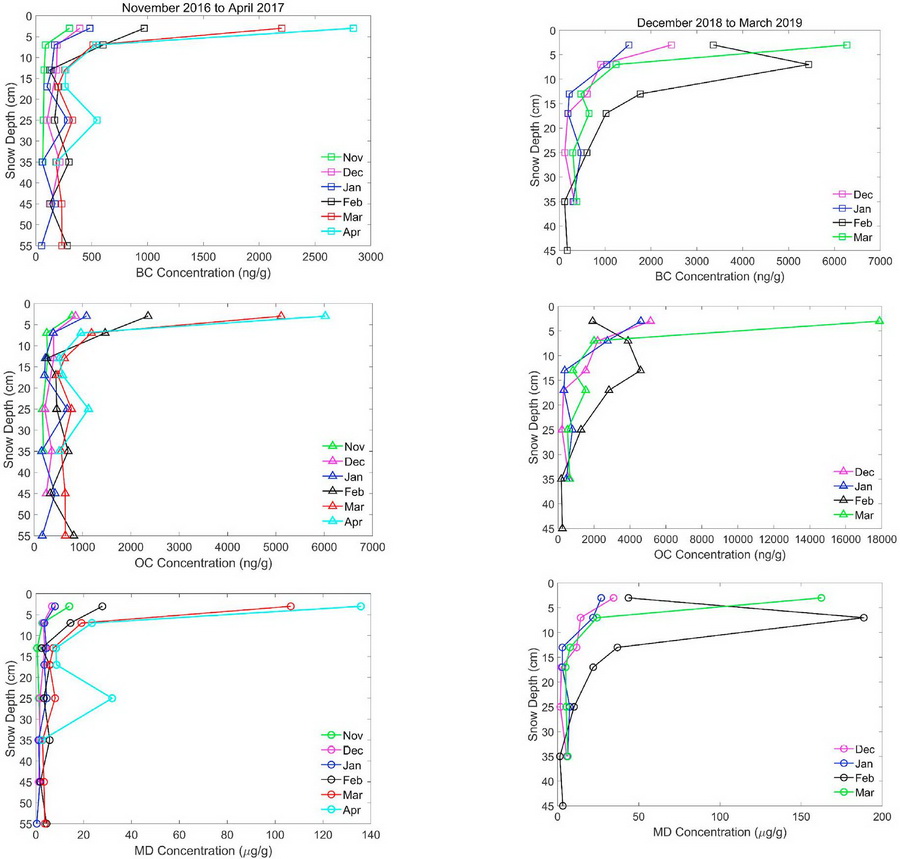Enrichment of Light Absorbing Impurities in Snow Might Accelerate Snowmelt in Southern Altai Mountains
Updatetime:2020-12-31From:
【Enlarge】【Reduce】
Light absorbing impurities (LAIs) (such as black carbon (BC), organic carbon (OC), mineral dust (MD), etc.) deposited onto the snow surface can darken the snow and cause decrease in snow surface albedo, resulting in increasing the absorption of solar energy, thereby accelerating snowmelt, shrinking snow cover duration and impacting hydrological cycle.
However, there is still a lack of understanding of the LAIs concentration, elution and enrichment process in snow cover in the northern Xinjiang (NX). Besides, the post-depositional enrichment processes of LAIs in seasonal snow cover and their potential impacts on snow across the NX are still unclear.
Recently, a research team led by Prof. KANG Shichang from the Northwest Institute of Eco-Environment and Resources (NIEER), Chinese Academy of Sciences (CAS), carried out continuously sampling during two years to investigate the concentrations, impacts and potential sources of LAIs in snow cover at Kuwei Station in the southern Altai Mountains.
In this study, they found that the average concentrations of BC, OC and MD in the surface snow were 2787±2334 ng g-1, 6130±6127 ng g-1, and 70.03±62.59 μg g-1, respectively, which dramatically increased along with snowmelt intensified, reflecting a significant enrichment process of LAIs at the snow surface (Fig.1).
With the simulation of the Snow Ice Aerosol Radiative model, BC was the main dominant factor in reducing snow albedo and radiative forcing (RF), its impact was more remarkable during the snowmelt period. The average contribution rates of BC to snow albedo reduction increased by 20.0±1.9% in spring compared with that in winter; meanwhile, the corresponding average RFs increased by 15.8±3.4 W m-2.
Besides, decrease in the number of snowmelt days caused by BC and MD together was 3~8 days. It indicated that surface enrichment of LAIs during snow melting might accelerate snowmelt further.
In addition, Weather Research and Forecasting Chemistry (WRF-Chem) model showed that the resident emission was the main potential source of BC and OC in snow (Fig.2). This implied that the mitigation of accelerating snowmelt needs to mainly reduce resident emission of LAIs in the future.
This work has been published in Environmental Pollution entitled “Continuously observed light absorbing impurities in snow cover over the southern Altai Mts. in China: Concentrations, impacts and potential sources”. Dr. ZHONG Xinyue and Prof. KANG Shichang are the first and corresponding authors, respectively.

Fig.1. Vertical variations of monthly mean LAIs concentrations in snowpit at Kuwei station during two snow cover years (Image by ZHONG Xinyue).

Fig 2. Contribution (%) of each emission source to the seasonal mean concentration of atmospheric BC (upper panel) and OC (bottom panel) simulated by WRF-Chem model for residential, industry and transportation from autumn 2016 through spring 2017 (Image by ZHONG Xinyue).
Contact:
ZHONG Xinyue
E-mail: xyzhong@lzb.ac.cn
Key Laboratory of Remote Sensing of Gansu Province, Northwest Institute of Eco-Environment and Resources, Chinese Academy of Sciences, Lanzhou 730000, China.
Appendix




